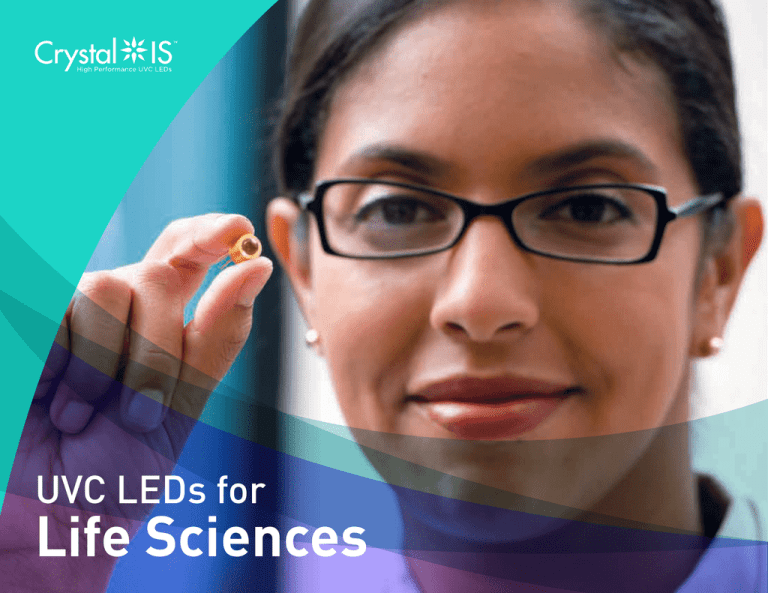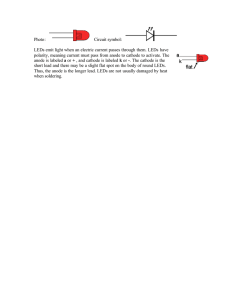
UVC LEDs for
Life Sciences
Life science instrumentation relies extensively on molecular spectroscopy for
several analyses that are essential for drug manufacturing, nucleic acid and protein
measurements as well as for observing events in living cells in real-time.
Advances in the bio-instrumentation sector give
rise to the following emerging needs in
instrument design:
• Compact instruments which minimize lab footprint
• Measurement of heat sensitive samples
• Quicker measurements which increase productivity
• Single parameter instruments which are cheaper
Traditionally, absorption and fluorescence
spectroscopy instruments have utilized broad
spectrum lamps such as xenon, mercury or
deuterium, as these generate ample light across
multiple wavelengths. However, in order to develop
scientific instruments that meet evolving needs in
the industry, adoption of alternative light sources,
such as LEDs, is essential. Crystal IS UVC LEDs
have several attributes that make them the
undisputed choice.
High Performance UVC LEDs for
Life Science Instrumentation
COMPARISON OF LEDs WITH TRADITIONAL LAMPS FOR SPECTROSCOPY
LED
Deuterium Lamp
Xenon Flash Lamp
Mercury Lamp
Spectrum
Single Peak
Broad Spectrum
Broad Spectrum
Broad Spectrum
Stability of Light
Output
Excellent temporal
Good
and spatial stability
Relatively Poor
Relatively Poor
Warm Up Time
Instantaneous
20–30 Minutes
Instantaneous
1–15 Minutes
• Industry leading light output
Thermal Effect on
Samples
None*
Heat-sensitive
samples can be
affected
None
Heat-sensitive
samples can be
affected
• Superior light output maintenance over time
Cost of Ownership
Low**
High
High
Low
• Excellent spectral quality
Drive Electronics
Simple
Complex
Complex
Complex
Safety
Low voltage and
cold light source
Hot bulb surface;
High voltage power
supply
High voltage supply
High voltage
and contains
supply; Ignition and
mercury in fragile
sparking risk
quartz envelope
Crystal IS manufactures high performance UVC
LEDs in the 250–280 nm wavelengths using
proprietary aluminum nitride (AlN) substrates and
cutting-edge LED fabrication technology. Our LEDs
offer higher light outputs and longer lifetimes than
other UVC LEDs, making them ideal for emerging
spectroscopic applications in the life sciences.
• Tolerates highest drive currents
* LEDs do not emit forward heat
** Lowered cost of ownership due to cost savings on power
supply and housing, and lack of filters required
Table 1. LEDs Compared with Traditional Light Sources
Simplicity of LED Drive Electronics
Enables Ease of Operation
Single Peak Benefits for Spectroscopy
In any single spectroscopic application, light at a
discrete wavelength is useful for the measurement,
and filters are typically used to suppress any
undesired wavelengths from a broad spectrum UV
lamp. This approach can diminish the intensity at
all wavelengths, including the desired wavelength.
Moreover, adding filters to the optical path adds to
the cost of the design.
Unlike the broad, complex spectra of UV lamps,
deep UV (UVC) LEDs have simple spectra—a
single peak with narrow spectral bandwidth.
Monochromaticity of LED light sources avoids
loss of light through filtering. Crystal IS LEDs
allow users to select wavelengths that match the
specific absorption peaks of target molecules or
the specific excitation wavelength of fluorophores
in their spectroscopy applications.
LEDs provide a low voltage, low direct current
option to traditional UV light sources. LEDs have
relatively inexpensive drivers whose lifetimes
exceed hundreds of thousands of hours, and are
capable of providing the required current input to
LEDs over their entire lifetime.
In contrast, traditional UV light sources require
higher voltages to increase light output and have
more complex requirements for power supplies
and ancillary electronics. This has implications
for safety, cost, thermal management and ease
of operation.
This simplicity of electronics for LEDs enables
more compact product designs and packages
and opens options for product evolution or
tailoring for specific applications.
Stability of Light Output for Measurement
Accuracy and Reliability
Instant On/Off Capabilities Enhance and
Enable Applications
Stability of light output is critical to ensuring low
baseline noise and increased detection limits in
absorbance measurements. LEDs are notably
stable light sources, unencumbered by the
mechanisms, which lead to fluctuations in other
traditional UVC light sources. Stability of light
output in LEDs is impacted primarily by junction
temperature, which can be maintained with a host
of simple thermal management techniques.
Unlike filament-based or arc-based UV lamps,
LEDs reach their full brightness in under a
microsecond once turned on and do not have
a prolonged glow when turned off. This instant
on/off results in conservation of energy during
operation and longer replacement cycles for LED
light sources.
* UV light source warm up
time data as pulled from
typical product literature
•
•
•
•
•
•
•
Peak wavelengths from 250 nm to 280 nm
Light output bins from 0.5-4+ mW
Ball lens with viewing angle of 15°
Drive currents up to 100 mA
Hermetically sealed
RoHS-compliant
TO-39 package
High Performance Liquid
Chromatography (HPLC)
DNA Purity Measurement
Biological techniques such as polymerase chain
reaction (PCR) and DNA sequencing have specific
target or window of nucleic acid concentration
for optimum performance, necessitating reliable
measurements of the concentration and purity of
proteins and nucleic acids.
Quantitative analysis is based on the BeerLambert’s law—the relationship between degree of
absorption and the concentration of the absorbing
material. Both protein and DNA absorb UV light,
but they have different absorbance curves. UV
spectroscopy saves time in optimizing the reaction
and reduces use of costly reagents by measuring
the ratio of absorbance at 260 nm (pure DNA/RNA)
and 280 nm (protein contaminants) to determine
the purity of the sample.
Crystal IS UVC LEDs used in these instruments
increases efficiency, decreases costs and improves
the quality of measurements.
• High spectral quality of Crystal IS LEDs provides
measurement linearity over a wide concentration range
• Small footprint enables compact product design to
maximize lab real estate
• Instant on/off leads to greater number of sample
measurements to increase productivity
• Single peak and simple drive electronics allow for less
costly, application-specific instruments
HPLC has several applications in the pharmaceutical
industry from drug discovery through development
and manufacturing. It is used for analyzing complex
mixtures, purifying chemical compounds, developing
processes for synthesizing chemical compounds and
in raw material quality control.
UV absorption spectroscopy is the most popular
detection technology in HPLC since many analytes
absorb in the UV spectrum while solvents remain
transparent at these wavelengths. Nearly 80 percent
of all known chemicals and materials can be
identified with HPLC including aromatic carboxylic
acids (255 nm), water soluble vitamins, analgesics
(280 nm) and proteins (280 nm).
Crystal IS LEDs provide several benefits in HPLC:
• Little or no forward heat protects thermally sensitive
samples
• Instant on/off increases lab bench productivity
• Emission pattern allows for easy alignment
• Light source and the associated electronics can be
isolated from the flow cell for explosion proof applications
Fluorescence Imaging
Protein Research
Fluorescence microscopy with UV light is used for
live cell imaging to understand protein interactions
and offers insights not possible using fixed cell
techniques. High-throughput imaging of protein
crystallization experiments with UV light helps
crystallographers accurately differentiate between
crystals of protein and those of salt, and eliminates
errors associated with human inspection.
Protein research is integral to targeted drug
development as well as disease diagnosis.
Aromatic amino acids in proteins such as
tryptophan (Trp), tyrosine (Tyr) and phenylalanine
(Phe) fluoresce when excited with UVC light. The
shape and magnitude of the intrinsic fluorescence
spectrum is used to identify local environment of
amino acids, determine proximity relationships and
measure events in living cells in real-time.
Crystal IS LEDs provide several benefits in
fluorescence imaging:
• Modulation capability of LEDs eliminates high-speed
mechanical shutters for vibration-free experiments
• Stability of light output and precise intensity control
make it possible for images to be taken under identical
excitation conditions for long term experiments
• Lack of forward heat eliminates thermal effect on
samples and increases cell viability
• Uniform illumination across the field of view for data
accuracy in quantitative imaging
Time-resolved fluorescence provides more
information about the molecular environment of
the fluorophore than steady-state fluorescence
measurements. Many macromolecular events
occur on the same time scale as fluorescence
decay. Thus, time-resolved fluorescence
spectroscopy can be used to investigate these
processes and gain insight into chemical
surroundings of the fluorophore.
Benefits of Crystal IS LEDs for core protein
research:
• Narrow spectrum for selective excitation of different
amino acids
• Lack of forward heat and use of remote light sources
eliminates thermal effects on samples
• Instant on/off facilitates instantaneous modulation
for time resolved measurements
Crystal IS UVC LEDs
Our UVC LEDs offer higher light outputs
and longer lifetimes than other UVC
LEDs, making them ideal for emerging
spectroscopic applications in life sciences.
Compared to traditional UV sources,
LEDs are monochromatic, more compact,
environmentally friendly and provide lower
cost of ownership.
We invite you to discover the power of Crystal
IS UVC LEDs.
70 Cohoes Avenue
Green Island, NY 12183
U.S.A.
www.cisuvc.com
518.271.7375
sales@cisuvc.com
© 2014 Crystal IS, Inc. All rights reserved. Crystal IS, the Crystal IS logo and Optan are trademarks of
Crystal IS, Inc. and/or its affiliates. All other trademarks are the property of their respective owners.
1009-1312





